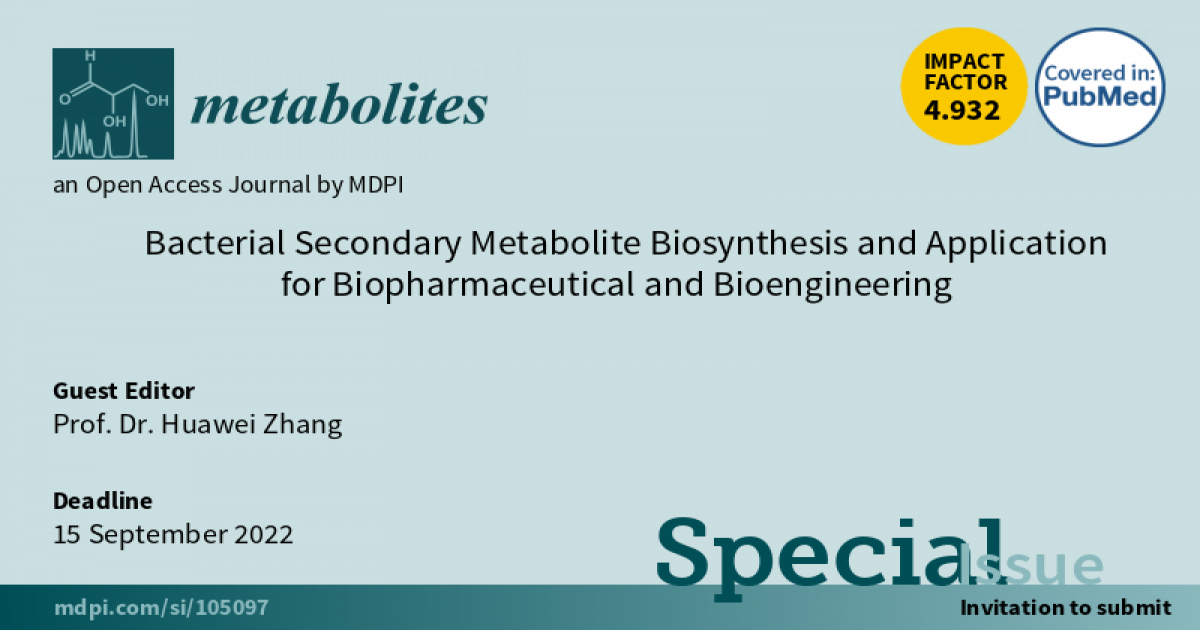Bacterial Secondary Metabolite Biosynthesis and Application for Biopharmaceutical and Bioengineering
A special issue of Metabolites (ISSN 2218-1989). This special issue belongs to the section "Microbiology and Ecological Metabolomics".
Deadline for manuscript submissions: closed (15 September 2022) | Viewed by 5200

Special Issue Editor
Interests: marine drug leads; efficient discovery; biosynthesis; fermentation preparation
Special Issues, Collections and Topics in MDPI journals
Special Issue Information
Dear Colleagues,
Bacterial natural products (NPs) are some of the most important sources of therapeutic agents. These NP-based drugs have made a tremendous contribution to human health throughout the world since they constitute half of the pharmaceuticals on the market today. However, the emerging and re-emerging infectious diseases (e.g., drug-resistant pathogens, coronavirus variants) pose complex and serious challenges to the global public health and the need for new antibiotics is highly urgent. In the past two decades, bacterial NPs have greatly decreased. Fortunately, the application of new interdisciplinary approaches (e.g., genome mining and shuffling, metabolomics, ribosome engineering, heterologous expression) has substantially improved our ability to discover and develop novel functional biomolecules from these microbes and reinvigorated interest in natural product research in recent years.
This Special Issue welcomes both fundamental research papers and critical review works in the most recent and innovative developments of bacterial NP biosynthesis and application for biopharmaceutical and bioengineering. We sincerely wish that this issue can collect groundbreaking contributions in this field.
Prof. Dr. Huawei Zhang
Guest Editor
Manuscript Submission Information
Manuscripts should be submitted online at www.mdpi.com by registering and logging in to this website. Once you are registered, click here to go to the submission form. Manuscripts can be submitted until the deadline. All submissions that pass pre-check are peer-reviewed. Accepted papers will be published continuously in the journal (as soon as accepted) and will be listed together on the special issue website. Research articles, review articles as well as short communications are invited. For planned papers, a title and short abstract (about 100 words) can be sent to the Editorial Office for announcement on this website.
Submitted manuscripts should not have been published previously, nor be under consideration for publication elsewhere (except conference proceedings papers). All manuscripts are thoroughly refereed through a single-blind peer-review process. A guide for authors and other relevant information for submission of manuscripts is available on the Instructions for Authors page. Metabolites is an international peer-reviewed open access monthly journal published by MDPI.
Please visit the Instructions for Authors page before submitting a manuscript. The Article Processing Charge (APC) for publication in this open access journal is 2700 CHF (Swiss Francs). Submitted papers should be well formatted and use good English. Authors may use MDPI's English editing service prior to publication or during author revisions.
Keywords
- new bacterial NP discovery and biosynthetic analysis
- antibiotic biosynthesis
- extending metabolite diversity
- genome mining and metabolomics
- gene characterization and heteroexpression
- activation of cryptic gene cluster of secondary metabolite
- enhancement of valuable metabolite production






